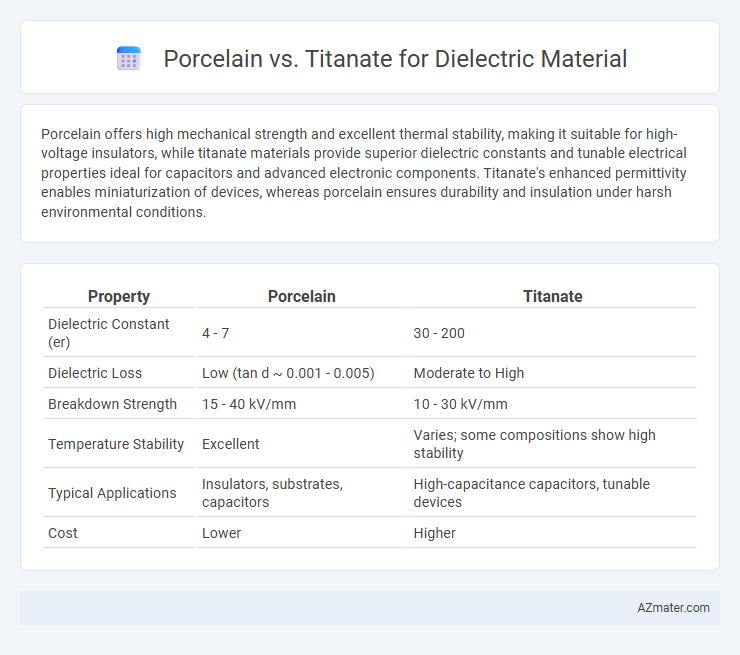Porcelain offers high mechanical strength and excellent thermal stability, making it suitable for high-voltage insulators, while titanate materials provide superior dielectric constants and tunable electrical properties ideal for capacitors and advanced electronic components. Titanate's enhanced permittivity enables miniaturization of devices, whereas porcelain ensures durability and insulation under harsh environmental conditions.
Table of Comparison
| Property | Porcelain | Titanate |
|---|---|---|
| Dielectric Constant (er) | 4 - 7 | 30 - 200 |
| Dielectric Loss | Low (tan d ~ 0.001 - 0.005) | Moderate to High |
| Breakdown Strength | 15 - 40 kV/mm | 10 - 30 kV/mm |
| Temperature Stability | Excellent | Varies; some compositions show high stability |
| Typical Applications | Insulators, substrates, capacitors | High-capacitance capacitors, tunable devices |
| Cost | Lower | Higher |
Introduction to Dielectric Materials
Dielectric materials such as porcelain and titanate play a crucial role in capacitors and electronic insulation by storing and releasing electrical energy efficiently. Porcelain, known for its high mechanical strength and thermal stability, offers moderate dielectric constants ideal for applications requiring durability over extreme temperature variations. Titanate compounds, particularly barium titanate, exhibit very high dielectric constants and low dielectric losses, making them preferred in high-performance capacitors where enhanced permittivity and miniaturization are critical.
Overview of Porcelain as a Dielectric
Porcelain, a ceramic dielectric material, offers high dielectric strength and excellent thermal stability, making it suitable for insulating electrical components in high-voltage applications. Its microstructure provides good mechanical strength and resistance to moisture, contributing to reliable performance in harsh environments. Porcelain's composition typically includes kaolin, feldspar, and quartz, which enhance its insulating properties and durability.
Overview of Titanate-Based Dielectrics
Titanate-based dielectrics, primarily composed of barium titanate (BaTiO3), exhibit high dielectric constants and strong temperature stability, making them essential in capacitors and high-frequency applications. Their perovskite crystal structure facilitates excellent ferroelectric and piezoelectric properties, surpassing traditional porcelain dielectrics in energy storage density. Titanate dielectrics demonstrate superior performance in multilayer ceramic capacitors (MLCCs) due to their tunable electrical characteristics and reliability under varying operational conditions.
Key Electrical Properties Comparison
Porcelain exhibits a high dielectric strength typically around 15-30 kV/mm and a dielectric constant ranging from 6 to 10, providing stable insulation for medium voltage applications. Titanate ceramics, such as barium titanate, offer a significantly higher dielectric constant, often exceeding 1000, which enhances capacitance in compact electronic components but usually at the cost of lower dielectric strength compared to porcelain. The dielectric loss tangent in titanate materials varies widely depending on composition but generally remains higher than porcelain, affecting energy efficiency in high-frequency applications.
Dielectric Strength: Porcelain vs Titanate
Porcelain typically exhibits a high dielectric strength ranging from 12 to 25 kV/mm, making it suitable for high-voltage insulators and capacitor substrates. Titanate materials, especially barium titanate, have lower dielectric strength values, generally around 4 to 15 kV/mm, but they provide significantly higher dielectric constants, enhancing capacitance performance. The choice between porcelain and titanate for dielectric applications depends on the specific requirements for dielectric strength and permittivity in electrical insulation and capacitor design.
Thermal Stability and Performance
Porcelain exhibits high thermal stability with a melting point around 1,650degC, making it ideal for applications requiring consistent dielectric performance under extreme heat. Titanate materials, such as barium titanate, offer superior dielectric constants but lower thermal stability, typically degrading above 300degC. For high-temperature environments, porcelain is preferred due to its stable dielectric properties and resistance to thermal shock, while titanates excel in applications prioritizing high permittivity at moderate temperatures.
Manufacturing Processes and Costs
Porcelain dielectric materials require high-temperature firing processes involving kaolin, feldspar, and quartz, which result in longer sintering cycles and higher energy consumption, increasing manufacturing costs. Titanate dielectrics use chemical synthesis and lower temperature processing methods like sol-gel or solid-state reactions, reducing energy use and enabling faster production times. Although titanate materials often have higher raw material expenses, their streamlined manufacturing lowers overall costs compared to the more complex and energy-intensive porcelain production.
Common Applications in Industry
Porcelain and titanate are widely used dielectric materials with distinct industrial applications due to their electrical and thermal properties. Porcelain is commonly utilized in high-voltage insulators, circuit breakers, and capacitors because of its excellent mechanical strength and thermal stability, making it ideal for power transmission and distribution systems. Titanate, particularly barium titanate, is favored in electronic industries for multilayer ceramic capacitors (MLCCs) and piezoelectric devices, offering high dielectric constant and tunable electrical properties essential for miniaturized components and sensors.
Long-Term Reliability and Durability
Porcelain exhibits excellent long-term reliability and durability due to its high resistance to environmental stresses, mechanical strength, and minimal dielectric degradation over time. Titanate materials, while offering superior dielectric constants and improved capacitance, may face challenges with aging effects and thermal stability, potentially impacting their long-term performance. Careful material selection based on application conditions is critical to optimize dielectric reliability and lifespan in electrical insulation systems.
Conclusion: Choosing the Right Dielectric Material
Porcelain offers mechanical strength and excellent temperature stability, making it ideal for high-voltage insulators and outdoor applications. Titanate ceramics provide superior dielectric constants and low loss tangents, suitable for miniaturized capacitors and high-frequency circuits. Selecting the right dielectric material depends on balancing electrical performance requirements, environmental conditions, and mechanical durability to optimize device reliability and efficiency.

Infographic: Porcelain vs Titanate for Dielectric Material
 azmater.com
azmater.com